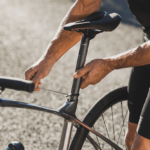The answer to this question is that mountain bikers whip their bikes because they want to keep the momentum going and maintain or increase their speed. It also helps them go up and down hills with ease as well. A rider can use this move to launch themselves off jumps, sliders, or any other obstacle.
Whips are most commonly used by riders that feel that they “can not” control their bike. They tend to happen when riders are speed maniacs or they can no longer control their bike because they got tired and with that way, they can spend less energy.
Some cyclists do not use whips because it is considered a bad thing, or it can be dangerous if done wrong.
Without a doubt, Mountain bikers that are beginners or not too experienced should not whip because it is only useful in certain situations and doing it wrong can lead to crashes and even worse injuries.
As you understood from the introduction and the title, this article is right for the mountain bike whips and the fans of bike tricks.
What is a whip in mountain biking?
A whip is a practice trick where the rider throws the bike from side to side using their arms. Also, it is a skilful trick that is performed by throwing the bike from side to side using your arms. This trick can be used to clear obstacles, but it should never be used as a way of jumping over them.
The whips are mainly meant to push the rider forward, so they don’t lose speed as they descend a steep hill or as they go up a steep hill. This helps them maintain gravity so the rider can stay stable on the bike as it goes over bumps and rocks. The momentum generated by these whips is what pushes them forward during the fast descents of a mountain bike trail.
As we mentioned before, this trick is the most feared technique in mountain biking. It’s unpredictable because it can easily be transformed into very dangerous situations or it can be used to send a message to other riders.
If you want to learn more about the risk of mountain biking, you can take a look at our recent mountain biking dangers and injuries blog post.
Whipping is often seen as an aggressive maneuver that scares other riders, but some people use it more strategically than others. Some people use it to get on top of rivals while others use it to get out of tricky technical situations.
A whip is a cause of confusion, frustration, and even injury for many mountain bikers. It’s the act of rotating the handlebars around the steering axis to turn or lean, while the cyclist is in the air before landing.
Why do mountain bikers turn their handlebars when they jump?
Turning the handlebars while jumping is an essential trick of the whip and that’s the main reason we see mountain bikers doing that. But what is behind this move? Let’s find it below.
Mountain bikers turn their handlebars so that they can generate more force with their upper body to pull themselves up at the moment of the jump.
The rider’s weight is put on the handlebars when in the air and in order to make this trick, they need to turn the bars away from the jump.
Some mountain bikers are turning their handlebars sideways or at an angle when they jump. This is called a “jumping switch.”
Mountain bikers do this to avoid catching their back wheel on the lip of the ramp or jumping and flipping over backwards.
The main reason for this is that it provides a more controlled direction of flight and helps them control their bike better in general.
Also, Mountain bikers turn their handlebars because they want to maintain the balance of the bike. When they jump, the weight shifts towards the front of the bike. This causes it to tilt and if they don’t counter-steer, it’ll cause them to crash, so they have to be very careful while doing this.
How do you whip on a mountain bike? (Step-by-Step Guide)

To be a proficient mountain biker, you need to know how to whip on a mountain bike. It is a technique of turning the handlebars in order to make your bike turn quickly in the desired direction.
A Mountain Bike is a great way to explore the wilderness and off-road terrain. It also offers a more “back to nature” experience for many riders.
First of all, you have to know how to jump with your bike. If you don’t know how to jump here’s a useful article with helpful tips to jump.
It’s not always easy to get going when you’re on a mountain bike. You need to become aware of your body and use your core strength in order to get the momentum going, then continue using that momentum by leaning into the turns and following it through with your upper body.
A whip is a short, sharp, sudden turn that a rider performs to change directions quickly. It can be performed either by propelling oneself sideways from the bike and then back on again or by using the handlebars for leverage.
You should only try whip turns only when you want to avoid some obstacles or as an evasive maneuver in high-speed downhill sections.
So, here is the step-by-step guide we made especially for you that will show you how to whip on a mountain bike with ease:
- Sit on your seat and push your weight back over the rear wheel
- Hold onto the handlebars with both hands
- Twist your upper body and arms into an L-shape
- Pull up hard with one arm, while pushing down with the other arm and this will cause the bike to turn sharply in one direction
- Keep repeating this process for each corner until you reach your destination.
Conclusion
Summing up, in this article we have mentioned several things related to mountain biking whips and how a mountain biker can perform a whip. Our suggestion before performing this trick is to get to know your bike very well, and know when and where to perform a whip. Also, you should avoid performing it if you are a beginner, inexperienced or if you want to avoid the risk of getting injured. In addition, it is essential for all the riders to wear all the important equipment in order to be safe and avoid difficult moments.





